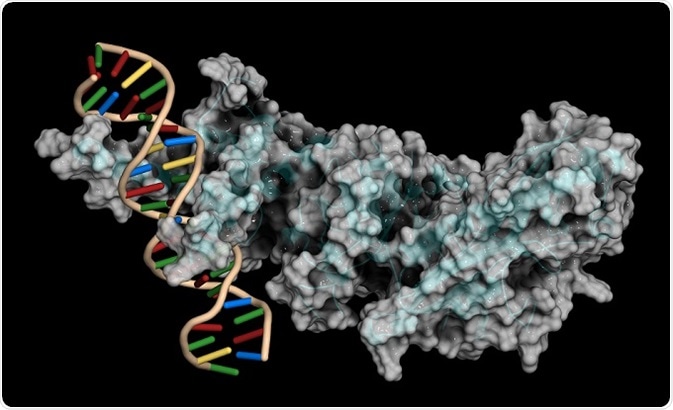
Image Credits: molekuul_be/shutterstock.com
Chromosome instability is a key hallmark of cancers, increasing mutation rates and helping tumor cells evade destruction by the immune system as well as treatment by medical interventions. Hypoxia contributes to this instability, causing replication stress and a subsequent loss of the cellular machinery required to deal with DNA damage.
A recent paper published in Molecular Cell details the discovery that the RRM2B subunit of ribonucleotide reductase (RNR) promotes continued DNA replication and survival in cancer cells under hypoxic conditions. Lead author Dr. Iosifina Foskolou and colleagues at the University of Oxford, UK used electron paramagnetic resonance (EPR) spectroscopy among other techniques to show that RRM2B retains stability and activity in the near-absence of oxygen, allowing cancer cells to continue proliferating despite this stress.
In this study, the authors found that RRM2B depletion reduced cancer cell viability by 77% in hypoxic conditions, reducing xenograft tumor growth and increasing sensitivity to radiological insults. Elevated apoptotic markers were seen specifically in RRM2B-depleted tumor regions devoid of oxygen, highlighting the importance of this protein in hypoxia.
This study employed EPR using the Bruker-Biospin Micro EMXplus spectrometer in order to determine the stability of RNR subunits in hypoxia. RRM2B retained 66% stability in the presence of <0.1% oxygen, while RRM2 had only 43% stability. What’s more, the authors found a set of lysines that may be critical to the elevated activity profile of RRM2B in hypoxic conditions.
Two lysines, found at positions 37 and 151 in RRM2B, showed reduced stability in hypoxia when converted to glutamic acids. Interestingly, molecular dynamics simulations revealed that these two mutations caused RRM2B to adopt a conformation very similar to that of RRM2, indicating that the more “open” conformation of wild-type RRM2B may underlie its increased activity in the absence of oxygen.
These findings open up the exciting possibility of a novel cancer drug target. “Our data suggest that targeting R1/R2B enzyme specifically in hypoxic tumor cells might be an effective therapeutic strategy,” the authors state. Molecules capable of inhibiting RRM2B by inducing a shift towards the “closed” conformation may reduce RRM2B activity and increase tumor cell death and susceptibility to other therapeutic agents.
Other methods of inhibition may also be explored, including the blockade of oxygen entry into the RNR holoenzyme, which Dr. Foskolou and colleagues found is elevated when RRM2B is present, as compared with RRM2. The authors also highlight siRNA against RRM2B as a potential therapeutic avenue, similar to clinical trials of siRNA against RRM2. Based upon the current findings, the RRM2B siRNA may offer improved efficacy in this context.
This study highlights the importance of EPR technology in cancer research. Due to the poor prognosis that remains in many types of cancer, new drugs are desperately needed that can safely and effectively improve patient survival. By targeting RRM2B, which is overexpressed in a number of cancers, researchers may be able to reduce cancer survival and mutagenesis.
Further research is needed to determine whether RRM2B inhibition can improve patient survival in animal models and humans with solid tumors. However, in tumor samples from colorectal adenocarcinoma patients, the authors found an association between p53-dependent RRM2B expression and hypoxic markers, highlighting the relevance of RRM2B to human disease.
EPR technologies such as the Bruker-Biospin Micro EMXplus spectrometer allow researchers to study dynamic changes in unpaired electrons within a protein. In the present study, the authors observed changes in tyrosyl radicals generated during RNR activity in the de novo generation of deoxyribonucleotide triphosphates (dNTPs). In so doing, the researchers were able to determine both the stability and structural conformation of RRM2B in hypoxic conditions. Compared with nuclear magnetic resonance (NMR), EPR offers improved sensitivity, and can be used within a shorter time-frame and in larger molecules.
EPR can also be used in conjunction with a spin-labeled protein, in which a stable radical is used to label a specific location within a protein, which can then be monitored dynamically for changes in structure. Bruker, the world’s premier supplier of EPR systems, offers a number of highly sensitive and accurate spectrometers that can be used in diverse fields and applications, ranging from structural biology to quantum physics.
References:
- "Cancer Statistics." National Cancer Institute. https://www.cancer.gov/about-cancer/understanding/statistics.
- Burrell RA, et al. Replication Stress Links Structural and Numerical Cancer Chromosomal Instability. Nature. 2013;494:492–496.
- Hammond EM, Kaufmann MR, and Giaccia AJ. Oxygen sensing and the DNA-damage response. Curr Opin Cell Biol. 2007;19:680–684.
- Foskolou, IP, Jorgensen C, Leszczynska BK, et al. “Ribonucleotide Reductase Requires Subunit Switching in Hypoxia to Maintain DNA Replication.” Mol Cell. 201;66:206–220.
- Leighl NB, Laurie SA, Chen XE, et al. A phase I/II study of GTI-2040 plus docetaxel as second-line treatment in advanced non-small cell lung cancer: a study of the PMH phase II consortium. J Thorac Oncol. 2009;4:1163–1169.
- Oh YK and Park TG. siRNA delivery systems for cancer treatment. Adv Drug Deliv Rev. 2009;61:850–862.
- Jørgensen CL, Ejlertsen B, Bjerre KD, et al. Gene aberrations of RRM1 and RRM2B and outcome of advanced breast cancer after treatment with docetaxel with or without gemcitabine. BMC Cancer. 2013;13:541.
- Chae YK, Anker JF, Carneiro BA, et al. Genomic landscape of DNA repair genes in cancer. Oncotarget. 2016;7:23312–23321.
- Klug CS and Feix JB. Methods and Applications of Site-Directed Spin Labeling EPR Spectroscopy. Biophysical Tools for Biologists, Volume One: In Vitro Techniques Methods in Cell Biology. 2008:617-658
About Bruker BioSpin - NMR, EPR and Imaging

Bruker BioSpin offers the world's most comprehensive range of NMR and EPR spectroscopy and preclinical research tools. Bruker BioSpin develops, manufactures and supplies technology to research establishments, commercial enterprises and multi-national corporations across countless industries and fields of expertise.
Sponsored Content Policy: News-Medical.net publishes articles and related content that may be derived from sources where we have existing commercial relationships, provided such content adds value to the core editorial ethos of News-Medical.Net which is to educate and inform site visitors interested in medical research, science, medical devices and treatments.